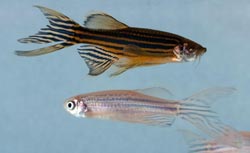Zebrafish use sunscreen also for camouflage

Zebrafish with different pigmentation and camouflage. The bottom animal is on a light subsurface. The top animal is blind, thus incapable of discerning the lightness of the subsurface and<br><br>Picture: Stephan Neuhauss / UZH<br>
Neurobiologists from the University of Zurich have discovered that this camouflage mechanism actually started out as sunscreen to protect the fish against DNA damaging shortwave solar radiation at embryonic stages.
For diurnal animals like zebrafish embryos, which grow up in shallow pools and are practically see-through, exposure to the sun constitutes a major problem since ultraviolet (UV) radiation damages DNA.
Neurobiologists Stephan Neuhauss and Kaspar Müller from the Institute of Molecular Biology at the University of Zurich set about investigating which mechanisms zebrafish embryos use to protect themselves against the aggressive UV radiation. Interestingly, the two scientists reveal in their article recently published in the journal PLOS ONE, the UV-protection mechanism also doubles as camouflage.
Sunscreen already from day two
For their study, the scientists examined zebrafish embryos, the skin cells of which already possess pigments known as melanosomes from the second day after fertilization – even before their eyes have developed. “In strong solar radiation, the pigments spread along predetermined paths within the cells, after which the zebrafish embryo appears darker,” explains Neuhauss. As the researchers discovered, this distribution process of dark pigments in the presence of intense light always takes place, regardless of whether the embryo is on a light or dark subsurface. Surprisingly, the embryos display a noticeable change from the third day after fertilization: They adapt to the subsurface. According to Neuhauss, this is because the embryos can see from day three and have eyes with UV-sensitive photoreceptors in the retina. From this moment on, they are able to discern whether they are on a light or dark subsurface and can adapt and thus camouflage themselves accordingly. As long as the animal is in the embryonic stage and see-through, however, the benefits of UV protection prevail.
When the skin is no longer transparent and does not require protection against aggressive radiation, the selective distribution of the pigments within the skin cells is predominantly used for camouflage purposes. And with good reason: Being able to adapt to a lighter or darker subsurface and camouflage yourself reduces the chance of being spotted and eaten. “The original UV protection turns into a camouflage mechanism – a striking example of the secondary use of an existing capability,” Neuhauss concludes.
Literature:
Kaspar P. Müller, Stephan C. F. Neuhauss, Sunscreen for Fish: Co-option of UV light protection for camouflage. PLOS ONE. January 29, 2014. Link: http://dx.plos.org/10.1371/journal.pone.0087372
Media Contact
More Information:
http://www.mediadesk.uzh.ch/index.htmlAll latest news from the category: Life Sciences and Chemistry
Articles and reports from the Life Sciences and chemistry area deal with applied and basic research into modern biology, chemistry and human medicine.
Valuable information can be found on a range of life sciences fields including bacteriology, biochemistry, bionics, bioinformatics, biophysics, biotechnology, genetics, geobotany, human biology, marine biology, microbiology, molecular biology, cellular biology, zoology, bioinorganic chemistry, microchemistry and environmental chemistry.
Newest articles

First-of-its-kind study uses remote sensing to monitor plastic debris in rivers and lakes
Remote sensing creates a cost-effective solution to monitoring plastic pollution. A first-of-its-kind study from researchers at the University of Minnesota Twin Cities shows how remote sensing can help monitor and…

Laser-based artificial neuron mimics nerve cell functions at lightning speed
With a processing speed a billion times faster than nature, chip-based laser neuron could help advance AI tasks such as pattern recognition and sequence prediction. Researchers have developed a laser-based…

Optimising the processing of plastic waste
Just one look in the yellow bin reveals a colourful jumble of different types of plastic. However, the purer and more uniform plastic waste is, the easier it is to…



